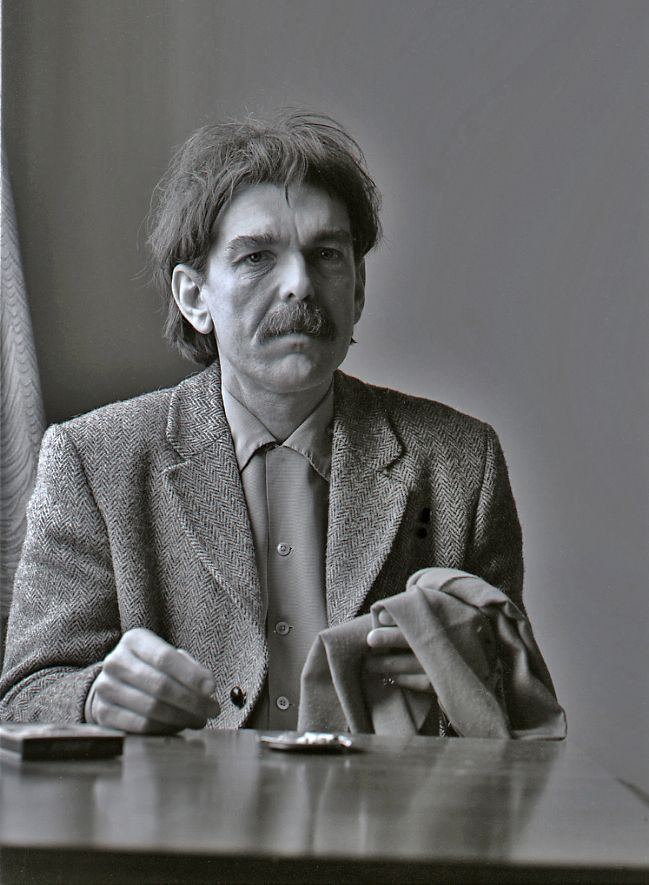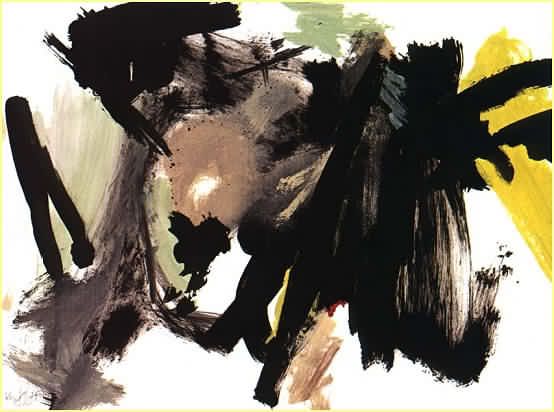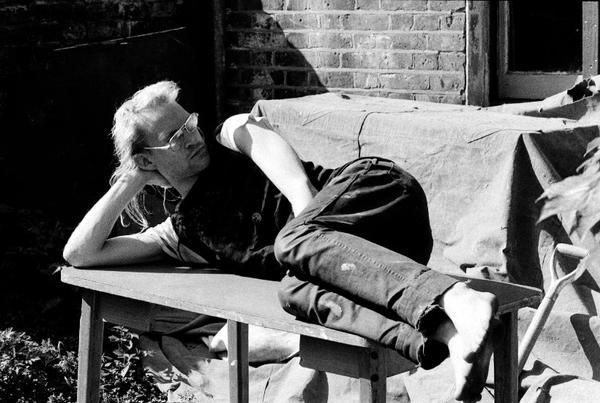

I own several Beefheart LP’s including the double set from 1970 ‘Trout Mask Replica’, but decided to upload the ‘Doc At The Radar Station’ LP tonight as this was the very first Beefheart LP that was purchased by a much younger Penguin. I decided on bagging this LP after hearing some of the tracks off this LP on the John Peel night time show, and also to a lesser extent, after hearing a track on the ‘Cash Cows’ compilation LP released by Virgin records which I used to own for my sins. Actually that’s a little unfair as the compilation was not too bad but the Beefheart track was I thought, one of the highlights amongst some pretty mediocre material (XTC / The Professionals / Mike Oldfield). It did have The Ruts and P.I.L on it though, but whatever, I digress.
I placed some money into someone’s grubby little hands at Virgin records underneath the street in Oxford Walk, W1 (now long long gone, Jim ‘Feotus’ Thirwell used to work down there) and took the plunge into the mind of Beefheart when I got home. Enjoyed the trip immensely to the extent that I then followed this release by purchasing the ‘Ice Cream For Crows’ LP a year or so later. I tried to source out the older material which was not that easy in the days before ebay and discogs et al. It was harder in those days just trying to find information of what Captain Beefheart actually released pre the early 1980’s, again decades before being able to just enter Captain Beefheart in a google or similar search engine! Still, through trial and error and countless visits to secondhand record shops throughout the 1980’s I eventually got a whole heap of early LP’s. I was then, as I am now, content with my Beefheart collection.
Anyway this LP from 1980 is a stonewall classic and I would advise browsers to seriously source further releases by Captain Beefheart especially the LP’s I have mentioned above.
The Don Van Vliet art and the three newspaper reviews of ‘Doc At The Radar Station’ written out below are taken off a wonderfully fulfilling Beefheart site, beefheart.com.

‘Doc At The Radar Station’ review written by Robert Palmer, taken from the 28th September 1980 edition of The New York Times
Captain Beefheart and his Magic Band probably would have been an anomaly had they burst on an unsuspecting world anywhere, at any time. Ironically, the Captain, whose real name is Don Van Vliet, grew up in Southern California and put together his first magic band in Los Angeles in the mid-60’s. Joni Mitchell, Jackson Browne, and other future pop icons were singing folk music and their own sensitive ballads at the Troubadour, the Ash Grove offered pure folk and blues, and the Birds were setting Bob Dylan’s folk songs to rock-and-roll rhythms. For harder rock, one could listen to garage bands. Frank Zappa, who was equally fond of 50’s doo-wop and the electronic moonscapes of Edgard Varese, was beginning to compose pop music that was considerably more adventurous, but even Mr. Zappa’s early work must have seemed a little tame compared to Captain Beefheart and his Magic Band.
The Captain had been on television in Los Angeles at the age of 15, demonstrating his talents as a painter and sculptor, and his music sounded something like action painting or abstract sculpture translated into sound. Rhythms stopped, started, crossed, collided, and fell apart in a manner that seemed pre-planned but was nevertheless disorienting. Metallic guitars playing blues-like parts in no discernible key clashed and slashed and then miraculously melded into whiplash unisons. Beefheart sang chains of free-association images in a huge, gruff voice that spanned a number of octaves. When he recorded his first album (”Safe as Milk,” Buddah Records, 1967), he included a number called ”Electricity” that called on the full range and power of that voice, and his singing shattered a $1,200 microphone. When he wasn’t singing, he was often punctuating the music with whooping harmonica breaks or bursts of manic saxophone playing.
The band that recorded ”Safe as Milk” included John ”Drumbo” French, who as been the magic band’s percussionist off and on ever since, and it included Ry Cooder, a guitarist with country blues leanings who has since made a name for himself as a folk and pop eclectic. The music was transitional, closer to its evident blues roots than anything Captain Beefheart has recorded since and more conversant with pop and rhythm-and-blues song structures. By the end of 1967, Mr. Cooder was gone and the music was full-blown, uncompromising Beefheart.
In 1969, a new magic band, with only the guitarist Antennae Jimmy Semens remaining from earlier groups, recorded ”Trout Mask Replica” for Straight Records, a company founded by Frank Zappa. The album is generally considered Beefheart’s masterpiece, but to these ears ”Lick My Decals Off,” issued by Straight/Reprise the following year and including ”I Love You, You Big Dummy,” ”I Wanna Find a Woman That’ll Hold My Big Toe Till I Have to Go,” and ”The Smithsonian Institute Blues,” is superior. In any event, Beefheart made two more fine albums for Warner Brothers in the early 70’s. But he was an acquired taste; his records sold only to a devoted cult following. Captain Beefheart blamed the record companies for not promoting him; the record companies blamed his music and the bizarre appearance of the Magic Band, whose clothing and bizarre demeanour on the back cover of ”Trout Mask Replica” (Antennae Jimmy Semens was wearing a baseball cap and, over his shirt and slacks, a frumpy housedress) must have led more than one record executive to fear the worst.
Many of Beefheart’s fans assumed that the Captain had taken more LSD than any human being on earth, with the possible exception of the other members of his Magic Band. In the late 60’s and early 70’s, it was easy enough to interpret the clattering rhythms and crazed bellowing one heard on Beefheart records as some kind of free-form psychedelic tribal stomp, but anyone who thought that misunderstood the music entirely. In his music, as in his art, Beefheart is almost entirely self taught, but he is also exceptionally systematic. He whistles or hums melodies and ideas for instrumental parts into a tape recorder and then painstakingly teaches the parts to his musicians, who generally have very little interpretative leeway. The rhythms that disintegrate before your very ears, the xylophone riffs that suddenly appear out of nowhere and cut across the polyrhythms set up by the other instruments, the impossibly dense and atonal chord clusters, all these effects are plotted in advance and painstakingly rehearsed. Casual listeners may still consider Beefheart a wild-eyed primitive, but in fact he’s an American maverick composer who has created his own musical idiom – an idiom that’s related to blues and rock-and-roll but also problematically tangential to them.
Captain Beefheart’s music was innovative from the very beginning, but until the late 1970’s it wasn’t really influential. One occasionally heard saxophone squawks or fractured rhythms and recognised a strain of vintage Beefheart, but his idiom retained its integrity and resisted imitation. The mid 70’s were rough years for him. He attempted to reach a broader audience with two compromised and lacklustre albums for Mercury, made a brief appearance as guest vocalist on a 1975 Frank Zappa album, and then disappeared until 1978, when Warner Brothers/Virgin issued a new LP, ”Shiny Beast (Bat Chain Puller)” that recaptured much of his old ferocity.
Meanwhile, a number of otherwise disparate rock artists who were popularly lumped together as ”new wave” began making music that was unmistakably (and in most cases admittedly) Beefheart influenced. From New York Talking Heads (whose leader David Byrne cites ”Trout Mask Replica” as an early inspiration) to the ex-Sex Pistol John Lydon and his Public Image Ltd., from Cleveland, Ohio’s abrasive Pere Ubu to the popular B-52’s from Georgia, from the English post-punk band Magazine (which recorded a Beefheart song in homage) to the jazz saxophonist Ornette Coleman (whose ventures into electric music bear traces of his mid-70’s friendship with Beefheart), it seemed that almost every interesting rock musician (and more than a few commercially successful ones) were working in areas Beefheart had opened up.
Just when the Beefheart influence began to seem strong enough to overwhelm Beefheart himself, the Captain began recording a new album that’s turned out to be his best record in years, and very possibly the best of his career. ”Doc at the Radar Station,” which Virgin/Atlantic is releasing this week (VA 13148), finds him singing with the energy of a wild man half his age (he’s 39), playing soprano saxophone and bass clarinet with renewed vigour, and leading a revitalised magic band that has learned his idiosyncratic style to perfection. His new songs mix Delta blues riffs (Beefheart is the only white artist who understood and was able to build on the essentially polyrhythmic nature of much early Delta blues) with snippets of synthesised strings that remind one of Stravinsky. Unequal phrase lengths, shifting meters, and rhythms that change radically every few lines keep the unwary listener perpetually off balance.
”Making Love to a Vampire With a Monkey on My Knee,” which is probably the most extravagantly original and perfectly realised creation of Beefheart’s career, involve screams, bits of Cecil B. DeMille-like fanfare, and mercurial changes in instrumentation that fool one into thinking an orchestra is playing when it’s a five-man band with no overdubs. The lyrics are as original and vivid as any Beefheart has written. The album also includes two pristine instrumental pieces in which guitars play things no guitarist would ever have imagined. The rest of the album is exhilaratingly consistent, prime Beefheart.
Is the world ready? Captain Beefheart and the Magic Band are embarking on a European tour later this fall, their first full scale assault on the continent in five years, and then they’ll be touring America. Their venues may include dance clubs as well as concert halls, and now that people are dancing to the likes of Pere Ubu and Ornette Coleman, they’ll probably dance to Captain Beefheart, too. Meanwhile, the Captain broods in his trailer in the Mojave Desert, listens to late Beethoven and Stravinsky (he reportedly considers the new wave rock he’s heard impossibly crude, especially rhythmically), and bides his time.
Will his records sell this time around; will people throng to hear him play? It’s too early to tell. But ”Doc at the Radar Station” finds a neglected American genius back in the rock vanguard, and that’s surely where he belongs.

‘Doc At The Radar Station’ review written by Carman, taken from the January 1981 Down Beat.
Of all musicians loosely considered rockers, Captain Beefheart is the most original. Because his music is a genre unto itself, it’s particularly difficult to describe. Analogy, the efficient critics tool, gets nowhere near the heart of Beefheart’s creations.
Beefheart’s late ’60s work was virtually all self composed, and he taught it note by note, beat by beat, to his Magic Bands. This is probably still true; on Run Paint hear Bruce Fowler, occasional db Pro Session writer, whinny on trombone like a rabid equine. In the beginning, Beefheart relied heavily on blues forms and his own intense, rasping vocals – the closest known voice is Howlin’ Wolf’s. Beefheart also dabbled in pop, soul and folk forms, adding jazz-like reed parts, electronic studio effects and odd meters. His innovative earlier work hasn’t become MOR, but sounds far less peculiar to 1980 ears.
The Captain has continued forward, and still makes all other rock music seem tame. He’s beyond merely modifying the blues and even scorns the work of the new wave rockers who claim him as an influence (“Why should I look through my own vomit?” he asked Lester Bangs in the Village Voice). Though his vocals retain blues mannerisms and his lyrics employ a wacky (yet still traditional) blues hyperbole, Doc At The Radar Station displays throughout Beefheart’s own voice: a coarse, incredibly intense speak-singing.
This album may be the most successful utilisation of the harmolodic ideas articulated by Ornette Coleman. The Captain’s working method is different from Coleman’s; instead of seeking ideas from sidemen, Beefheart claims to dictatorially control his Magic Band members. In description, the music reads like jazz, though. Rhythms are carried by the singer and by all instruments – most often by electric guitars. Drums and percussion usually create subordinate, overlapping patterns. Conventional melody and harmony aren’t prime features, but what exists is played by all the musicians. For most tunes here, Beefheart writes catchy ostinatos which, since several are played simultaneously, seem to undermine each other. As these lines persist, they become more compatible, sometimes resolving into jagged unisons. On the most successful tunes, like Sheriff Of Hong Kong, listeners can’t help stomping.
Dirty Blue Gene is one of the highest evolutions yet of composer – arranger Beefheart’s technique. The opening frantic guitar chording soon gives way to blister fingered single note runs – separate lines by two players. At times, the drummer tightly supports a soloist; at others, he seems to he ignoring the band completely. Controlled feedback shrieks from nowhere; rhythms shift and stop altogether, to he reintroduced by guitar power chords; churning slide guitar drives the tune toward its end. Over it all, Beefheart sings one of the great love songs, about a woman who’s “not bad … just genetically mean.” The Captain’s howls of suffering and the brutality of the woman “swingin’ a sponge on the end of a string” are hilarious and somehow, simultaneously, heartfelt. This tune (and others here) will remain on my playlist for at least the short decade until I’m as old as the Captain (39).
Doc is thoughtfully programmed. Hot Head, even with its highly percussive guitars, is structured like a Top 40 tune. Ashtray Heart features guitar-drum “unison,” and, like all the tunes, off the wall lyrics that are funny or empathetic, depending on the listener’s mood. Two brief instrumental numbers function mostly to relieve the tension of the Captain’s strange sprechesang.
Beefheart is least successful where music and words aren’t well integrated; Sue Egypt and Brickbats come off as poetry recitations with musical backgrounds, although each element has its interest. Every tune contains nuggets, and in spite of its initial density, repeated listenings prove that this album wears well.
Most Down Beat reviewers are too liberal with stars, especially for rockers. Since journeymen like the Clash garnered five stars (London Calling) and won the Readers Poll for best rock album, and since I’ve awarded four and five stars to passionate tunesmith Elvis Costello, four and a half stars to Doc may seem insulting. It’s not. The U.S. government can’t control its inflation, but we can control ours. Next week, when London has stopped calling, hear the Captain howl.

‘Doc At The Radar Station’ review, writer unknown, taken from the 30th November edition of Circus.
As in Captain Beefheart’s best music over the past 14 years, at the cholesterol-filled heart of his new album there is one big, intriguing contradiction. The songs are crawling with grotesque lyrical imagery and bluesy, growling vocals over totally non-conventional music that all suggests a complete breakdown in our perception of things. Yet the weird part is, this is seldom music of despair or destruction. While some other, truly unconventional modern musicians call for elimination or speak of disillusion (Public Image or Lydia Lunch and 8 Eyed Spy), Beefheart’s music is more an act of joyous experimentation. This strange brew of anger and joy can be best seen in a song like “Making Love to a Vampire with a Monkey on My Knee.” It’s filled with Beefheart’s usual chaotic rifts, which scratch and claw their way into your heart, yet it ends with an inspiring delivery of the lyric: “death be damned.…. life.”
Accordingly, the album is stocked with buoyant, challenging rhythms and musical non-sequiturs, beginning with, say, a perfectly reasonable guitar rift that, is suddenly pulled apart by five other sounds zooming in at different angles. Beefheart fans will be used to these palsied rhythms but the pieces hardly come off as repetitions of the past. “Hot Head” has one of his most danceable beats ever, and in “Telephone,” Beefheart almost sounds like a singing version of Yosemite Sam. Also, on the album’s spoken parts he proves once again how successful he is at the skill of “reading” over music (something even Patti Smith has never done so naturally).


Many happy returns to Alistair Livingston whose birthday it is today. Alistair was one of the original Kill Your Pet Puppy scribes and is one of the four cogs that keeps KYPP online driving along the internet road nicely enough.
Have a nice relaxing birthday Al from the other three cogs at KYPP!

AL Puppy
September 30, 2010 at 12:37 amThank you! I remember listening to John Peel in his pre-punk days and him playing lots of Beefheart. Big Eyed Beans from Venus was and still is one of my favourites.
http://www.youtube.com/watch?v=sF9rZoN_-DU
Rich in Washington
September 30, 2010 at 4:19 amI keep meaning to drop you a line to tell you how much I appreciate your posts, musical shares and writings thereof.
This is great!
Thanks so much and keep up the good work!
gerard
September 30, 2010 at 5:17 pmHappy birthday AL! Get pissed, destroy.